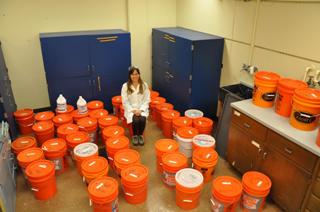Mar 4 2015
What do a human colon, septic tank, copper nanoparticles and zebrafish have in common? They were the key components used by researchers at the University of California, Riverside and UCLA to study the impact copper nanoparticles, which are found in everything from paint to cosmetics, have on organisms inadvertently exposed to them.
 Alicia Taylor, a graduate student at UC Riverside, sits surrounded by buckets of effluent from the septic tank system she used for her research. CREDIT: UC Riverside
Alicia Taylor, a graduate student at UC Riverside, sits surrounded by buckets of effluent from the septic tank system she used for her research. CREDIT: UC Riverside
The researchers found that the copper nanoparticles, when studied outside the septic tank, impacted zebrafish embryo hatching rates at concentrations as low as 0.5 parts per million. However, when the copper nanoparticles were released into the replica septic tank, which included liquids that simulated human digested food and household wastewater, they were not bioavailable and didn't impact hatching rates.
"The results are encouraging because they show with a properly functioning septic tank we can eliminate the toxicity of these nanoparticles," said Alicia Taylor, a graduate student working in the lab of Sharon Walker, a professor of chemical and environmental engineering at the University of California, Riverside's Bourns College of Engineering.
Taylor is a co-first author of a recently published paper, "Understanding the Transformation, Speciation, and Hazard Potential of Copper Particles in a Model Septic Tank System Using Zebrafish to Monitor the Effluent," in the journal ACS Nano. Other authors are: Sijie Lin (also co-first author), Zhaoxia Ji, Chong Hyun Chang, Nichola M. Kinsinger, William Ueng, Andre´ E. Nel and Walker.
The research comes at a time when products with nanoparticles are increasingly entering the marketplace. While the safety of workers and consumers exposed to nanoparticles has been studied, much less is known about the environmental implications of nanoparticles. The Environmental Protection Agency is currently accessing the possible effects of nanomaterials, including those made of copper, have on human health and ecosystem health.
The UC Riverside and UCLA researchers dosed the septic tank with micro copper and nano copper, which are elemental forms of copper but encompass different sizes and uses in products, and CuPRO, a nano copper-based material used as an antifungal agent to spray agricultural crops and lawns.
While these copper-based materials have beneficial purposes, inadvertent exposure to organisms such as fish or fish embryos has not received sufficient attention because it is difficult to model complicated exposure environments.
The UC Riverside researchers solved that problem by creating a unique experimental system that consists of the replica human colon and a replica two-compartment septic tank, which was originally an acyclic septic tank. The model colon is made of a custom-built 20-inch-long glass tube with a 2-inch diameter with a rubber stopper at both ends and a tube-shaped membrane typically used for dialysis treatments within the glass tube.
To simulate human feeding, 100 milliliters of a 20-ingredient mixture that replicated digested food was pumped into the dialysis tube at 9 a.m., 3 p.m. and 9 p.m. for five-day-long experiments over nine months.
The septic tank was filled with waste from the colon along with synthetic greywater, which is meant to simulate wastewater from sources such as sinks and bathtubs, and the copper nanoparticles. The researchers built a septic tank because 20 to 30 percent of American households rely on them for sewage treatment. Moreover, research has shown up to 40 percent of septic tanks don't function properly. This is a concern if the copper materials are disrupting the function of the septic system, which would lead to untreated waste entering the soil and groundwater.
Once the primary chamber of the septic system was full, liquid began to enter the second chamber. Once a week, the effluent was drained from the secondary chamber and it was placed into sealed five-gallon containers. The effluent was then used in combination with zebrafish embryos in a high content screening process using multiwall plates to access hatching rates.
The remaining effluent has been saved and sits in 30 five-gallon buckets in a closet at UC Riverside because some collaborators have requested samples of the liquid for their experiments.